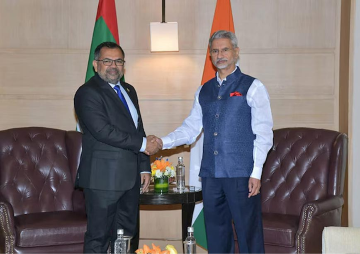
Pursuing gender equality remains a significant challenge in the 21st century. Despite notable advancements in fields such as education, healthcare, and economic engagement, there remains a persistent disparity in the representation of women in leadership positions across various industries. This disparity not only hinders the optimal utilisation of the labour force but also restricts societal progress. Existing evaluation criteria often prove inadequate as they fail to account for the intricacies of women's leadership trajectories, particularly in the Global South nations. To bridge this divide, a comprehensive quantitative approach that delves into the nuances of female leadership and empowerment is imperative.
Existing evaluation criteria often prove inadequate as they fail to account for the intricacies of women's leadership trajectories, particularly in the Global South nations. To bridge this divide, a comprehensive quantitative approach that delves into the nuances of female leadership and empowerment is imperative.
Reimagining gender indices
Several well-established indices have been crucial in assessing advancements in gender equality. The Global Gender Gap Index by the World Economic Forum and the Gender Inequality Index by the UNDP offer essential insights into various areas, including economic participation and political representation. Initiatives like the Women's Empowerment Principles by UN Women and the Women, Peace, and Security Index by Georgetown Institute shed light on specific facets of women's rights and inclusion. However, these measures often prioritise a limited number of indicators, primarily concentrating on outcome-driven data.
Initiatives like the Women's Empowerment Principles by UN Women and the Women, Peace, and Security Index by Georgetown Institute shed light on specific facets of women's rights and inclusion. However, these measures often prioritise a limited number of indicators, primarily concentrating on outcome-driven data.
These methodologies may present an incomplete picture, especially for women in developing nations such as India. For example, in September 2023, Indian lawmakers approved the Women’s Reservation Bill, which mandates that women hold a minimum of 33 percent of seats in state legislative assemblies and the Lok Sabha. However, a significant presence of women in the Indian legislatures may not accurately represent their impact on policy formation. These constraints highlight the need for a more comprehensive framework characterised by foundational elements that capture the multifaceted nature of women's empowerment and the diverse environments in which they function.
A multifaceted framework
-
Political leadership: Statistics reveal that women are inadequately represented in decision-making at all levels globally, indicating a distant achievement of gender balance in political spheres. Women's involvement in political realms is crucial to ensure the amplification of their voices and the crafting of laws that promote gender equality. This sphere encompasses not just the number of women in elected positions but also their impact within political factions, involvement in policy-forming entities, and efficacy in championing women's rights.
-
Entrepreneurship: Nurturing women's entrepreneurial ventures is pivotal for financial empowerment, generating employment opportunities and innovative advancements. This domain necessitates an exploration of elements influencing women's success in entrepreneurship, such as access to financial backing, mentorship initiatives, business connections, and supportive legislative frameworks.
-
Business leadership: Overcoming the barrier of advancement for women in corporate hierarchies continues to pose a significant hurdle. This field must concentrate on the representation of women in leadership roles across diverse sectors, encompassing corporations, non-profit entities, and community organisations. Data shows that the proportion of women in top leadership positions—defined as Director, Vice President (VP), or C-suite roles—stood at 32.2 percent, nearly 10 percentage points lower than the overall female workforce representation of 41.9 percent in 2023.
Figure 1: Women's Representation in the Workforce (Overall vs. in Leadership Roles, by Industry)

Source: World Economic Forum, Global Gender Gap Report 2023
-
Leadership in research and academia: The involvement and impact of women in academia are pivotal for knowledge generation, societal transformation, and communal progress. This domain assesses women's engagement in research endeavours, leadership positions within academic establishments, and their overarching influence on knowledge formation and innovation. According to data from UNESCO, less than 30 percent of the global researcher population comprises women. However, to authentically diminish the gender disparity, it is imperative to move beyond quantitative metrics and identify the qualitative aspects discouraging women from pursuing research careers.
-
Gender-responsive social protection and security: A secure and safe environment is essential for women in leadership positions. This field investigates the degree to which nations offer social safety provisions, including childcare facilities, healthcare availability, and legal remedies for acts of violence and bias. Furthermore, it evaluates the security protocols to guarantee women's safety in public areas and workplaces.
Figure 2: Regional Average Achievement Score for Gender-responsive Social Protection and Security

Source: Sustainable Development Goal 5, Target 5.1, UN Women
Cultivating leadership ecosystems
The analysis of various contexts provides valuable insights into the unique challenges and opportunities women encounter in different settings. This comprehensive understanding enables a nuanced comparison of countries across the development spectrum, facilitating a more equitable assessment of progress towards gender equality. Women's leadership brings diverse perspectives to decision-making processes, leading to more effective solutions across industries. Moreover, women tend to prioritise investments in education and well-being, contributing to a positive development cycle and increased efficacy in fostering lasting peace initiatives.
Women's leadership brings diverse perspectives to decision-making processes, leading to more effective solutions across industries. Moreover, women tend to prioritise investments in education and well-being, contributing to a positive development cycle and increased efficacy in fostering lasting peace initiatives.
In conclusion, while gender indicators offer a starting point, a deeper understanding of women's leadership and empowerment is crucial. Moving beyond surface-level outcome metrics is essential to identify the factors that enable women's leadership. This profound understanding can inform targeted policies and programmes to remove barriers and create an enabling environment for women to lead and thrive across all sectors. Further research efforts should focus on refining methodologies for data collection and analysis within this framework, facilitating the development of a more inclusive index that captures the complexities of women's leadership globally.
(The author acknowledges ORF intern and Pratham Ti Fellow, Arti Mahato, for her research assistance.)
Soumya Bhowmick is an Associate Fellow at the Observer Research Foundation
The views expressed above belong to the author(s). ORF research and analyses now available on Telegram! Click here to access our curated content — blogs, longforms and interviews.




 PREV
PREV


